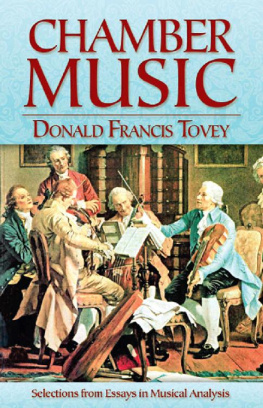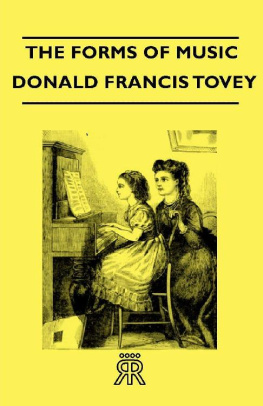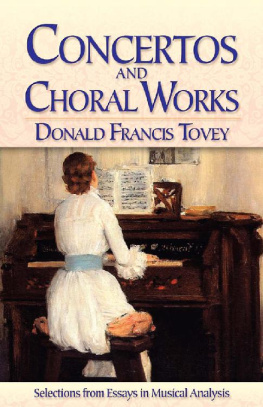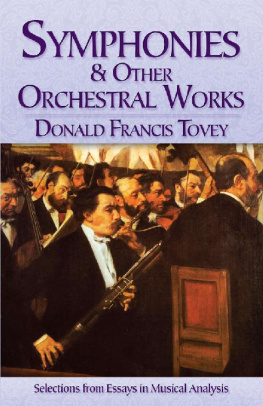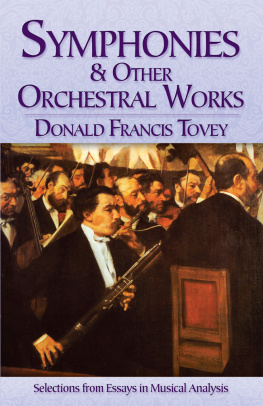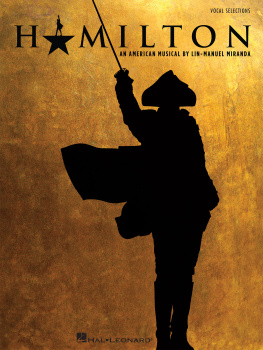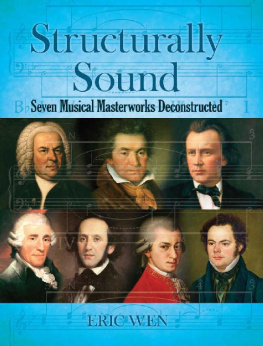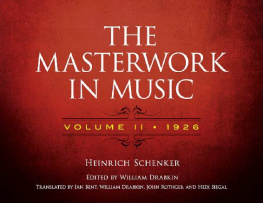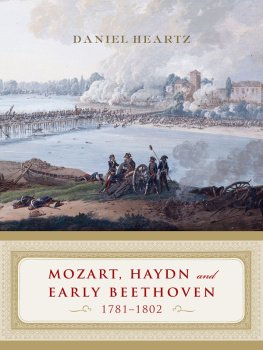CHAMBER MUSIC
Selections from Essays in Musical Analysis
D ONALD F RANCIS T OVEY
DOVER PUBLICATIONS, INC.
Mineola, New York
Bibliographical Note
This Dover edition, first published in 2015, is a republication of Chamber Music: Essays in Musical Analysis originally published by Oxford University Press, New York, in 1989.
Library of Congress Cataloging-in-Publication Data
Tovey, Donald Francis, 18751940.
Chamber music : selections from essays in musical analysis / Donald Francis Tovey.
p. cm.
This Dover edition, first published in 2015, is a republication of Chamber Music: Essays in Musical Analysis, originally published by Oxford University Press, New York, in 1989.
eISBN-13: 978-0-486-80141-4
1. Chamber musicAnalysis, appreciation. I. Title.
MT140.T69 2015
785.009dc23
2014027844
Manufactured in the United States by Courier Corporation
78449501 2015
www.doverpublications.com
CONTENTS
CHAMBER MUSIC
1. A GENERAL SURVEY
(1928)
L IKE most classical terms, chamber music has meant different things at different periods, and has developed by evolution, it is a mistake to try to reduce early and late products of an evolutionary process to a common definition. There are theoretical objections to any limit that can be proposed. These may be removed by a statement which clearly shows the relation of what is excluded from the main scope of this essay to what is included.
The great change which came over the whole art of music after the middle of the eighteenth century affected chamber music no less profoundly than it affected opera. Nobody would quarrel with a history of opera for beginning with Gluck, so long as it did not wholly ignore his antecedents, archaic, prophetic, and decadent. But the kind of operatic art from which Gluck revolted rested on principles so radically and, to our notions, so obviously wrong, that all attempts to revive it must savour of antiquarianism. This is not the case with the chamber music of the earlier eighteenth century ; its principles, though now obsolete, were consistent and true to the nature of the instruments, and its masterpieces can never become antiquated. And their quantity is enormous. The whole mass of the chamber music of Bach, Handel, the Italian violin masters, and the French clavecinists must be far more voluminous than the sum-total of important chamber music from Haydn onwards, even if vocal music be excluded. And to review it, or even to read a review of it, is a task at which librarians might quail.
Fortunately for the reader, though it cannot be ruled out on artistic grounds, it is all based on two principles which are radically opposed to those of the later classical chamber music. Accordingly, my first part is devoted to illustrating the theory and practice of the continuo in the earlier chamber music, with occasional remarks on the other archaic principle, the mechanical use of 4-foot and 16-foot stops on the harpsichord and organ, the instruments to which the continuo was entrusted.
Though much has been written about the continuo, no writer has hitherto shown its relation to the aesthetics of later chamber music. But unless this relation is clearly understood, we cannot properly understand the revolution effected by Haydn and Mozart, nor fully appreciate the qualities of purity and euphony in chamber-music style. The continuo and the use of 4-foot and 16-foot doublings represent important musical instincts. To ignore or misunderstand them is to deprive the earlier chamber music of its euphony.
In the later chamber music the continuo instinct sometimes reasserts itself (often without the composers realizing its origin) as an impurity of style; especially when he is in the habit of composing at the piano.
T HE C ONTINUO P ERIOD
For general purposes, chamber music may be defined as instrumental music written for a group of individual performers, and intended to be heard for its own sake in such rooms as are to be found in private houses. Dance music, and music intended to accompany the clatter of dishes at a princely table, exclude themselves from the category of music intended to be heard for its own sake.
The size of the room is not a matter for rigid definition ; the hundred-and-fifty years during which the classics of chamber music were composed were a period of royal and aristocratic patronage, and the rooms for which the music was designed were the rooms of palaces. And it is not an unmixed evil that chamber music should be heard in halls that are too large for it. The necessity can arise only because of a remarkable public demand for the highest and most spiritual form of music, and the acoustic disadvantages have a distinct value as a stimulus to the imagination. The listener nave enough to expect the ff of Schuberts D minor Quartet to sound loud in a concert-room holding an audience of 2,000, learns in five minutes to prefer spiritual to material values in music, if he can learn anything.
Nevertheless, the classical idea of chamber music implies bigness as well as intimacy, and the listener is not enjoying the normal effect of a trio or quartet unless the sound is filling the room. This classical notion of bigness determines the art-forms ; no classical chamber music is merely lyric. Beethovens Fugue in D major, op. 137, for string quintet takes less than four minutes to play, and begins and ends softly; but fugues are not lyrics, and Beethovens sketches for this opusculum are entangled with ideas of a fugal opening which afterwards took shape in the scherzo of the Ninth Symphony. Other short pieces of chamber music are either large sets of variations or fragments of projected complete sonata-schemes. Schumanns Mrchenerzhlungen and Dvoks Dumky Trio are exceptional groups of lyrics by composers who otherwise accept the classical view that a chamber work must contain at least one movement in developed conata form. This rule is a natural result of the feeling that when two or more people are gathered together to play music, they may as well take the opportunity of doing more than can be done by one person. In Germany it is even considered a solecism to call a duet concert a chamber concert ; chamber music is held to begin with trios. An upper limit has not been assigned. Mozarts Serenade in B flat for thirteen wind instruments is, for reasons which will appear in the course of this essay, within the limits of classical chamber music, though even the most experienced wind players will feel in its performance that a conductor adds much to the comfort of a group that is twice the size of the wind band of any symphony before Beethoven.
Mozarts group of thirteen, however, does not include trumpets and drums, that is to say, it includes nothing which is either enormously stronger in tone than the rest of the ensemble or enormously inferior to it in musical resource. The trumpet in Saint-Sanss little Septet is almost the only instance of the introduction of such powerful orchestral artillery into chamber music in a classical style, and here the classical style is jocosely archaic.
The double-bass (or, as in Mozarts Serenade, the contrabassoon) does undoubtedly bring into chamber music the question of inferiority in musical resource. This will be discussed later, but here we may conveniently note that inferiority in musical resource is not to be measured by the amount of conspicuous display, whether in melody or flourishes, but by the necessity for the use of the instrument. And the double-bass may obviously be very necessary for the support of so large a group as eight or more instruments.
The criteria thus far indicated for classical chamber music seem simple and not formidably exacting. Every part is to be necessary, and the ensemble is to be complete in itself. Therefore an instrumental group must be capable of making a coherent ensemble, so that, whatever the art employed in combining sounds on different planes of tone, the chamber music style does not encourage the use either of an instrument which cannot be allowed to use its normal strength, or of one which cannot make itself heard without constant strain on its own part and constant repression of the other instruments.
Next page
